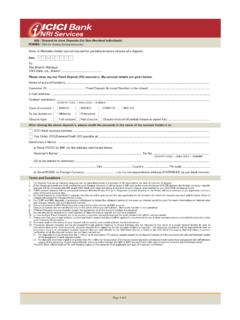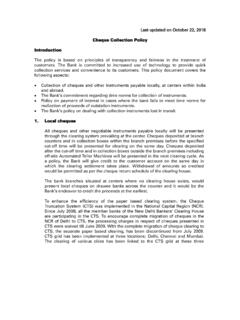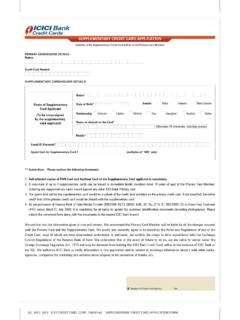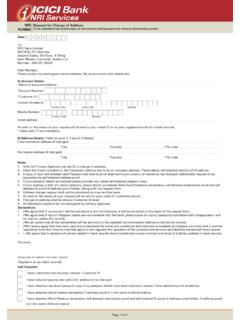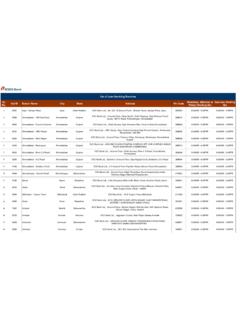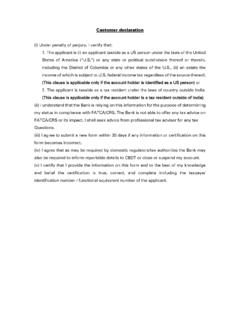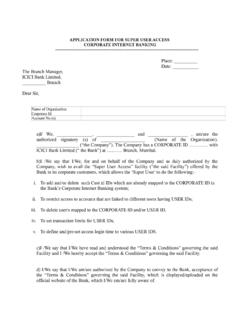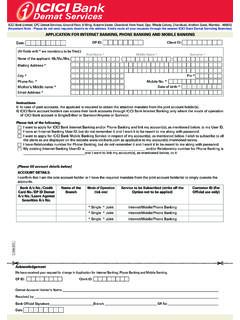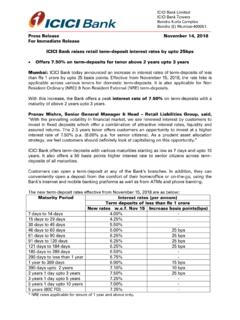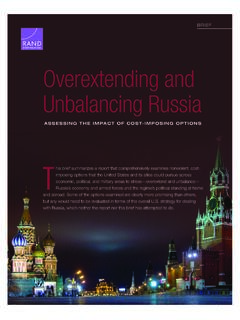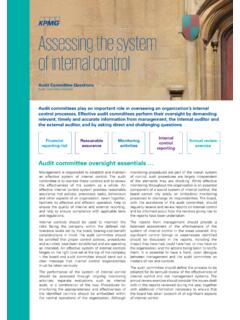Transcription of Russia and Ukraine conflict: Assessing the impact
1 Russia and Ukraine conflict: Assessing the impact Shivom Chakravarti Aniket Gaikwad 25-February-2022 Please see important disclaimer at the end of this report In 2014, Russian-Ukrainian conflict was more localized. However, this time around the conflict is far more geographically spread-out covering the entire Ukrainian territory As of now, sanctions imposed by US/Euro-zone/UK appear to be modest ranging from limiting access to financial markets for Russian state and a few designated entities and persons The more severe form of sanctions will be excluding Russia from the Swift payment system However, harsher sanctions will have an impact on consumers across the world given that both Russia and Ukraine are major suppliers of commodities Russia supplies 45% of world s pallidium, 15% of platinum and 9% of gold.
2 To Europe, Russia supplies as much as 50% of its gas requirements. Choking the supply chain implies higher prices for consumers Even so, energy and commodity prices have already moved higher. Oil prices are up by 29% CYTD21, metals are higher by 10%. Safe-haven gold has also moved up by 4% this year This will put upward pressure on US and EU inflation which is already at multi-decade high. Thus DM central banks will move forward with normalization plans but will calibrate the pace From a market s perspective, we see considerable volatility with the safe-haven trade likely to remain in place. We see a flat to downside trajectory for global bond yield movements We see strong support for the USD against the EUR, GBP and INR but not against the JPY or CNY Russia - Ukraine conflict has reached the end-game: On 24 February 2022, the Russian President stated that he would conduct a military operation in Ukraine s Donbas region to support separatist groups in eastern parts of Ukraine .
3 The Russian President also stated that his aim was for "demilitarization and denazification" of Ukraine . Hence, there appears to be a full-fledged assault underway with Russian forces poised to capture the Ukraine capital shortly. Media reports quoting western intelligence officials state that the aim of the invasion is to install a new government that will work closely with Russia . While Russia might take control of Ukraine over the next week itself, we think that there will be a new round of negotiations between the Western allied NATO forces and Russia that could continue for possibly another month or so. However, we have to continue to monitor daily developments closely and will remain nimble in terms of adjusting our projections depending on how the situation pans out accordingly.
4 Why the conflict?: It needs to be kept in mind that Ukraine was formerly part of the Soviet Union. After the break-up of the block, it got its independence but worked closely with Russia until 2014. The new government that formed turned its attention to seeking NATO membership. For Russia , the step of possible NATO membership for Ukraine will imply that it would break an important security breach for itself that it is trying to stop. At the same time, within Ukraine , there have been several separatist groups that were formed that kept allegiance with Russia . This resulted in Russia s annexation of Crimea back in 2014 and has resulted in the latest invasion. As we understand, NATO forces cannot directly come to the assistance given that Ukraine is not a member nation. At the same time, a key term for entering in to NATO membership is that the new entrant most resolve all disputes with its neighbouring nations before it can enter as a member.
5 With the latest round of conflict, Russia will be taking additional steps to curtail Ukraine s membership in to NATO. The Western response has been limited so far: The ability of the NATO forces to provide a direct military response remains limited. Besides, none of the Western allies would want to engage in a direct military conflict against Russia . Instead, the response has come by imposing several sanctions on Russia which is similar to response way back in 2014. The Sanctions (see appendix for a detailed list of measures) have focused on placing bans on: (a) banking sector assets with the US government targeting close to 80% of all Russian banking sector assets, (b) sanctions on a swath of high value individuals in Russia in the private and public sector respectively, (c) restricting the ability of Russian institutions to raise capital from the US/Eurozone and UK, (d) banning the trading of sovereign debt in the respective western markets and (e) banning export and placing export controls on semi-conductors and advanced technology.
6 Despite the bans in place on exports, Russia still has re-course to getting goods from China and the rest of EM Asia. Hence, export bans are unlikely to have a significant negative effect. The financial sanctions imposed so far appear to be fairly limited in nature in terms of possible impact . Global Markets Update Economics Research Group For private circulation only However, other more draconian measures such as removing Russia from the Swift payment system that would result in defaults in trade settlement payments or placing direct bans on the ability of Russia to export energy to the rest of the world have been avoided for the time being. Hence, the measures announced so far have remained fairly modest in nature. It appears that member nations want to also impose sanctions that do not have a direct negative effect on their respective economies.
7 The ability for the NATO members to impose sanction on the energy sector at time when energy prices have been on a structural uptrend remains limited. The upshot is that the sanctions imposed at the current juncture are unlikely to work as a game-changer in terms of halting the invasion. However, some of the draconian measures could still be considered and remain on the table in case the situation gets escalated further. We think that the removal of Russia from the Swift payment system will work as the most direst adverse impact on the economy given that sizeable number of transactions still take place in both the USD and EUR. The net result could be a wide-scale defaults in case such a measure is imposed. Chart 1: The USD and EUR are used extensively for trade transactions in Russia total trade transaction in Russia (%)RUBUSDEURO ther Source: CBR, Bloomberg & ICICI Bank impact on the global economy: The impact of the Russia - Ukraine conflict will be to further raise supply-side distortions in global commodity markets that have remained in place since 2021.
8 Given that Russia is the major producer and supplier of several commodities such as palladium, platinum, crude oil and gold, any disruptions will continue to push prices sharply higher. At the same time, Ukraine is a major supplier of wheat and corn to the European region in particular. Hence, global food prices will continue to rise sharply. The Bloomberg agricultural spot index has already reached a record high in response to the conflict that we think could remain in place for the time being. Chart 2: Russia is the major supplier of global commodities Chart 3: Ukraine supplies a substantial proportion of wheat and corn (%) Russia exports as a share of global production Source: CEIC, Bloomberg & ICICI Bank Research (%) Ukraine exports as a share of global production Source: WTO & ICICI Bank Research We think that the hit to the global economy might be more confined to the Euro-zone while other regions might not face as substantial a direct hit.
9 Euro-zone has the highest trade exposure as well as a substantial dependence on Russia for its energy needs. The US economy is unlikely to face a direct hit from the conflict given the low trade exposure. Neither will the Asian region for that matter face a substantial hit. Chart 4: Russia supplies nearly 50% of gas supply to Europe Chart 5: Europe is dependent on Russia for its commodity consumption 2440444649707794100020406080100 FrancePolandEuropeItalyGermanySlovakiaBu lgariaFinlandMacedonia(%)Share of gas supply from Russia Source: Bloomberg & ICICI Bank Research 0510152025 NetherlandsGermanyItalyPolandFinlandFran ceAustriaBelgiumDenmarkSwedenSpainCommod ity-wise imports from RussiaOilGasMetals(USD bn)( )( )( )( )( )( ) Source: Bloomberg & ICICI Bank Research The upshot is that the Russia - Ukraine conflict will raise the global inflationary profile but have a limited impact on the global economy with the exception of the Euro-zone.
10 Chart 6: Russia has strong trade-links with China and Europe but not with the rest of the world 020406080100120 ChinaGermanyNetherlandsBelarusTurkeySout h KoreaUKKazakhstanItalyPolandUSJapanUkrai neRussia: Trade with key partnersExportsImports(USD bn) Source: CEIC & ICICI Bank Research Global crude oil prices: A new trajectory: Prior to the conflict, our base-case was the demand-supply imbalances could persist in global crude oil markets in H12022. Demand was expected to continue to outstrip supply during this period by an average of mn barrels per day. However, demand-supply imbalances were projected to narrow considerably over H22022 given OPEC s commitment to increase supply levels gradually over the period. However, the demand-supply picture in global crude oil markets is likely to have been altered possibly structurally over 2022.
